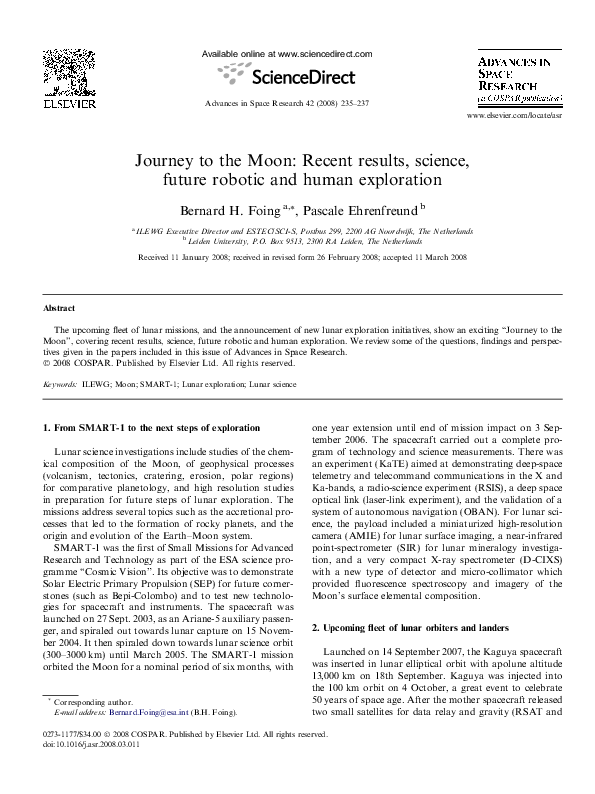Academia.edu no longer supports Internet Explorer.
To browse Academia.edu and the wider internet faster and more securely, please take a few seconds to upgrade your browser.
Journey to the Moon: Recent results, science, future robotic and human exploration
Journey to the Moon: Recent results, science, future robotic and human exploration
2008, Advances in Space Research
Related Papers
Acta Astronautica
ALCIDES: A novel lunar mission concept study for the demonstration of enabling technologies in deep-space exploration and human-robots interaction2018 •
Planetary and Space Science
Back to the Moon: The scientific rationale for resuming lunar surface exploration2012 •
2000 •
2005 •
Lunar Bases and …
The Second Conference on Lunar Bases and Space Activities of the 21st Century, volumes 1 and 21992 •
European Scientific Journal, ESJ
Perception des Exploitants Familiaux Producteurs de Maïs sur les Perturbations Climatiques dans l’Hinterland de Lubumbashi : Région du Haut-Katanga, RDCCette étude explore la manière dont les perturbations climatiques sont perçues par les agriculteurs familiaux qui produisent du maïs, notamment dans l’Hinterland de Lubumbashi. L’objectif de ce travail est de comprendre comment les exploitants familiaux de la région du Haut-Katanga en République Démocratique du Congo perçoivent les dérèglements climatiques et leurs impacts. Lors de discussions avec des agriculteurs familiaux de cinq villages, une approche d'enquête directe guidée par un questionnaire a évalué les niveaux de connaissances et les perceptions des parties prenantes sur le dérèglement climatique, ses causes potentielles et ses impacts apparents. Les données collectées ont été traitées et analysées statistiquement à l'aide du programme SPSS V25.0. Les résultats montrent que 95 % des agriculteurs percevaient les perturbations climatiques caractérisées par une reprise tardive des précipitations, des périodes de sécheresse plus longues qu'il y a plus de dix ans, une hausse des températures diurnes moyennes, des jours de plus en plus ensoleillés et une baisse du niveau d'eau des puits et des rivières. Les agriculteurs conviennent que ces perturbations ont un impact sur la productivité des cultures de maïs et que les pratiques actuelles telles que les feux de brousse, l'agriculture sur brûlis, la jachère, etc. sont non seulement peu durables mais peuvent également conduire à un dérèglement climatique. En conséquence, les agriculteurs de l’Hinterland de Lubumbashi sont témoins des perceptions climatiques et des effets qu’elles peuvent infliger au secteur. Cette étude montre que la perception des acteurs du dérèglement climatique n’entraîne pas de changements dans leurs pratiques agricoles actuelles en proportion des effets perçus et subits. This study examines how climate disruptions are perceived by family farmers who produce maize, particularly in the Hinterland of Lubumbashi. This work aims to understand how family farmers in the Haut-Katanga region of the Democratic Republic of Congo perceive climate disruptions and their impacts. Through direct interviews with family farmers in five villages using a guided questionnaire, the study evaluated their knowledge and perception of climate disruptions, potential causes, and visible impacts. The collected data was statistically processed and analyzed using SPSS V25.0. The results show that 95% of farmers perceived climate disruptions characterized by delayed rainfall, longer drought periods compared to over a decade ago, increased average daytime temperatures, increasingly sunny days, and decreased water levels in wells and rivers. Farmers agree that these disruptions impact maize crop productivity and that current practices such as bushfires, slash-and-burn agriculture, fallow fields, etc. are unsustainable and could exacerbate climate disruptions. Therefore, family farmers in the Hinterland of Lubumbashi witness the climate perceptions and the effects they can inflict on their sector. This study reveals that the actors' perception of climate disruption does not result in changes in their current agricultural practices proportional to the perceived and experienced effects.
RELATED PAPERS
2024 •
Proceedings of the International Scientific Conference - Sinteza 2019
Uticaj digitalnih tehnologija na odlučivanje izvršnih direktora i menadžera u cirkularnoj ekonomiji2019 •
2023 •
Clínica Contemporánea
Facilitando la separación psicológica de las mujeres en proceso de terminar una relación de pareja violenta2020 •
Indonesian Journal of Advocacy and Legal Services
Legal Education against the Impact of Social Media in the Era of Information Disclosure for Pringgokusuman Residents in Yogyakarta2019 •
1998 •
Veterinaria Noticias
Características Histológicas De Nervos Espinhais De Mamíferos2016 •
Postgraduate Medical Journal
Relapsing Salmonella enteritidis infection in a young adult male with chronic granulomatous disease1991 •
A. B. Knapp – S. Demesticha (eds.), Maritime Transport Containers in the Bronze-Iron Age Aegean and Eastern Mediterranean, SIMA PB 183, Uppsala 2016, pp. 57-77.
T. Pedrazzi (2016), Canaanite jars and the maritime trade network in the northern Levant during the transition from the Late Bronze to the Early Iron Age2016 •
Teoría de la Educación. Revista Interuniversitaria
La Animación Teatral: Los Procesos De Evaluación De Intervenciones Socioculturales Implementadas Por Medio De Técnicas Y Elementos Teatrales (1991)2009 •

 Pascale Ehrenfreund
Pascale Ehrenfreund